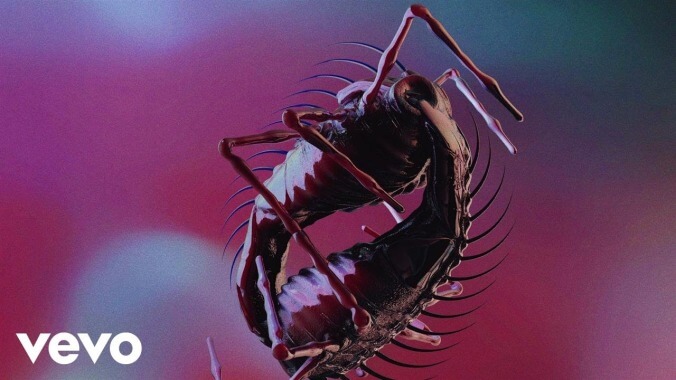The Horrors complete their evolution to greatness with V

The first time I ever saw The Horrors, frontman Faris Badwan threw garbage at me. It was an apt metaphor for what the band was doing in those days: Early singles like “Sheena Is A Parasite” and a cover of Screaming Lord Sutch’s “Jack The Ripper” were writhing, germy gobs hocked into that mid-’00s spate of British dance-rock bands, a poisonous antidote to so much pristine, skinny-tie precision, and Badwan and company quickly developed a reputation for being completely fucking batty live. Half the people at that 2007 SXSW showcase I attended came expecting some kind of cartoonish spectacle, and The Horrors certainly delivered. Badwan et al. took the stage dressed in Edwardian black under cascading eaves of hair, a black balloon tied to Badwan’s wrist, each of them looking like a cross between Birthday Party-era Nick Cave and an Edward Gorey drawing. They ripped through a short, furious set composed of its sole album at the time, Strange House, culminating in Badwan striding into the audience, grabbing an overflowing trash can, and launching its beer cans and barbecue wrappers into the packed house. People laughed and cheered; they got the gutter nastiness they came for. I doubt anyone expected to hear from The Horrors next year, or ever again.
But The Horrors surprised everyone, time and again. Their early, brutish sound—a gothic garage-punk amalgam of The Sonics and The Screamers, all yelps and screeching carnival organ—gave way to the stately psychedelic blurs of 2009’s Primary Colours, then to 2011’s majestic Skying and 2014’s gauzily romantic Luminous, which found a transcendent midpoint between grooving shoegaze and the emotive ’80s pomp of Simple Minds. Faced with the inevitable “what’s next?” where so many young bands falter and implode, The Horrors, as primed for burnout as any, made the oddly oft-overlooked choice to take a step back and focus on the music. In the process, they went from garbage-tossing gimmicks to studio rats, marking the difference between bratty kids bashing out some songs to get drink tickets and serious, career musicians. Even in an era that includes Radiohead and Liars, there may be no other modern band who’s achieved such an incredible evolutionary leap.
V, The Horrors’ fifth album, feels like the culmination of that steady, unlikely rise: It’s a swaggering, occasionally self-reflective record that sounds, for lack of a better term, really big. The group recently toured with Depeche Mode, and it seems to have rubbed off—and not just in songs that bear traces of that band’s vibe, from the strobe-lit, black-leather strut of “Machine” and “World Below” to the somberly soulful synth-romance of “Ghost” and “It’s A Good Life.” It’s also there in its own ability to make even smaller, shadowy moments feel arena-ready. But mostly, it’s there in how The Horrors have now amassed a similarly singular body of work that, for all its once-obvious influences, can’t be compared to anything but itself.
Produced by Paul Epworth—who similarly evolved from recording Horrors contemporaries like Bloc Party and Maximo Park to winning Grammys with Adele—V bears all the studio shimmer and refined flourish their pairing would suggest, with heavily treated guitars and synth burbles swooping in and out over carefully spaced arrangements of near-subliminal bass and electronic beats. Subsumed within those digital manipulations, Badwan, alternating between arms-open belting and a blissed-out sigh, seems to be consumed by the sort of existential questions that so many rock stars grapple with after years of press junkets and photo shoots.
“Are we hologram? / Are we vision?” Badwan asks in the Gary Numan-nodding opener “Hologram.” “Your mannequin moves / You ghost through the motions” he echoes on “Machine.” “When does it start to turn the shade into a shadow? / How does your life become a lie?” he asks on “Press Enter To Exit.” The pervasive sense of alienation—of being trapped, of feeling hollowed-out, of no longer recognizing yourself in the mirror—give V a loosely thematic thread, like a new-wave The Wall, to the point where the closing farewell of “It’s A Good Life” (“It’s a good life / Until it’s gone”) and “Something To Remember Me By” (“Two sides, a double life”) start to sound like reasons to alert the suicide hotline, or at least have his manager schedule him a vacation.
Still, it’s a beautiful fugue, and you can dance to it. V’s opening, back-to-back-to-back volleys—the stomping, soaring “Hologram,” into the hazy, Madchester groove of “Press Enter To Exit,” into the industrial snarl of “Machine”—are arguably the strongest in The Horrors’ catalogue. “Ghost” is a sparsely sinister, minor-key throb of organ, bluesy guitar bends, and brittle beats that explodes into a dazzling kaleidoscope of Terry Riley-esque synths. “Weighed Down” similarly builds from creeping, dubbed-out echoes to a symphony of strings and distortion; the mournful ambient swells of “Point Of No Reply” give way to one of the band’s most hauntingly beautiful chorus melodies; and even “Something To Remember Me By” offers a hopeful goodbye, exiting on a euphoric, pure trance outro.
The album stumbles slightly into the soporific on “Gathering,” which is built around a surprisingly stock acoustic guitar jangle—the one moment where the band’s willingness to push its boundaries yields somewhat generic rewards. But overall, V maintains a distinctively elegant gloom, The Horrors continuing to find intoxicating new shades within their gray moods. It’s an album that confirms them as one of the most consistently surprising, most artistically sophisticated, simply greatest rock bands working today; if only I could tell my ’07 self as he wiped the backwashed beer off his jacket.